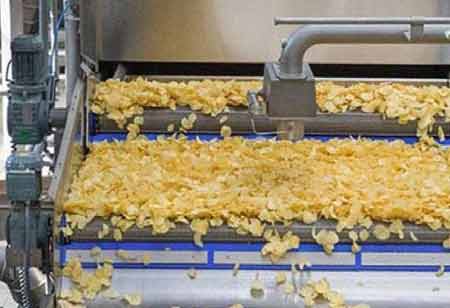Thank you for Subscribing to Food Business Review Weekly Brief
- Home
- Topics
- Alternative Proteins and Plant Based Food
- Beer and Wine
- Canned Beverages
- Coffee And Tea
- Food and Beverage Consulting
- Food and Beverage Financial Service
- Food And Beverages Marketing
- Food Distributors
- Food Ingredients
- Food Sustainability
- Plant Based Food and Beverages
- Seafood Suppliers
- Supplement Manufacturing
- Wine Investment
- News
- Vendor Viewpoint
- CXO Insights
- Conferences
- Newsletter
- CXO Awards
-
The Future of Food Processing Equipment

By
Food Business Review | Thursday, April 03, 2025
Stay ahead of the industry with exclusive feature stories on the top companies, expert insights and the latest news delivered straight to your inbox. Subscribe today.

The food production industry is undergoing an extraordinary transformation, spurred by evolving consumer demands, shifting dietary preferences, and remarkable technological advancements. At the forefront of this revolution are high-capacity mixers and pumps—essential components in large-scale food manufacturing. Concurrently, the surge in demand for plant-based and alternative proteins redefines the design and optimization of food processing equipment. Together, these trends are shaping the future of an industry central to modern lifestyles and global economic dynamics.
Rising Demand for High-Capacity Mixers and Pumps
In large-scale food production, efficiency, consistency, and scalability remain paramount as manufacturers strive to meet ever-growing consumer expectations. High-capacity mixers and pumps have emerged as critical tools, ensuring that bulk production processes maintain uniformity and precision. Several factors underscore their increasing importance.
Fast-paced lifestyles and the demand for convenient, ready-to-eat packaged foods have significantly boosted reliance on high-capacity mixers and pumps. These systems streamline production processes, saving time while safeguarding ingredient integrity—a necessity for modern food manufacturing. Additionally, consistency in flavor, texture, and overall product quality is vital for large-scale food processors seeking to adhere to stringent quality control standards. Advanced mixing technologies ensure uniform results across extensive production cycles, fostering consumer trust.
Technological innovation has further augmented the efficiency and functionality of these systems. Features such as energy-efficient motors, automated cleaning mechanisms, and intuitive control systems enable manufacturers to optimize productivity while minimizing costs and downtime. Moreover, the growing complexities of global supply chains necessitate robust and reliable high-capacity production facilities. With food manufacturers serving domestic and international markets, investment in cutting-edge mixing and pumping equipment has become crucial to maintaining competitive operations in an increasingly interconnected industry.
Addressing Trends in Plant-Based and Alternative Proteins
The rising demand for plant-based and alternative proteins has catalyzed significant changes in food development and processing practices. This trend has profoundly impacted the design and functionality of mixers and pumps, challenging manufacturers to adapt to new industry requirements.
Plant-based proteins present diverse characteristics, including viscosity, density, and texture variations. Modern equipment must exhibit greater versatility to handle such varied raw materials while ensuring precision and efficiency throughout production. Brands catering to health-conscious consumers prioritize nutrient-rich products, compelling manufacturers to integrate advanced dispersion systems that evenly incorporate essential vitamins, minerals, and functional ingredients.
Customization and flexibility have also gained prominence. Modular equipment allows manufacturers to tailor processes to meet specific production needs, such as emulsification or particle reduction. As eco-conscious, plant-based consumers seek alignment between product values and manufacturing practices, sustainability is another driving force. Innovations in equipment design include reduced energy consumption, efficient resource utilization, and water recycling during production cycles, thereby supporting greener manufacturing.
Maintaining robust hygiene standards is paramount, especially given plant-based production's heightened risk of microbial contamination. Equipment manufacturers have responded with seamless designs advanced cleaning mechanisms, and durable materials that ensure strict compliance with food safety protocols. Collectively, these advancements underscore the industry's focus on efficiency, adaptability, and sustainability in food processing equipment design.
Market Growth Drivers and Technological Integration
The food production equipment market has experienced dynamic growth, shaped by both macro and microeconomic factors. Population growth and urbanization have intensified the demand for large-scale food production, necessitating high-efficiency equipment solutions. Moreover, shifting consumer preferences—particularly the move toward healthier, sustainable, and plant-based food options—are compelling manufacturers to innovate and diversify their production capabilities.
Technological advancements are accelerating this transformation. AI-powered systems, IoT integration, and machine learning algorithms enable real-time monitoring, predictive maintenance, and enhanced operational control. These technologies improve productivity, reduce the risk of disruptions, and contribute to a more resilient and adaptable food production landscape. Additionally, the increasing digitization of supply chains fosters greater transparency and efficiency, ensuring that manufacturers can quickly respond to evolving market demands.
Shaping the Future of Food Manufacturing
The food production industry is poised for a new era, driven by advancements in high-capacity mixers, pumps, and other essential equipment. These technologies address the growing need for scalability and precision and align with emerging dietary trends, such as the increased demand for plant-based and sustainable products.
As consumer preferences evolve, the interplay between technological innovation and industry expertise will continue to shape food manufacturing processes. Modular and customizable equipment solutions powered by AI and IoT, will drive efficiency and enable the creation of diverse and personalized food products. Sustainability remains a guiding principle, with manufacturers embracing greener practices and integrating energy-efficient systems into their operations.
Ultimately, food production equipment manufacturers are well-positioned to deliver solutions that enhance operational efficiency, meet stringent safety standards, and cater to the diverse needs of a globalized market. By embracing these changes, the industry is set to redefine food manufacturing and processing for the future—offering innovative solutions that are as adaptable as they are essential to modern living.






